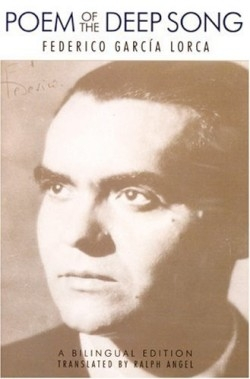Poem of the Deep Song
Most famous for his posthumous collection, Poet in New York, this poet is presented here at the beginning of his career, a young man full of passion for his country and its duende.
Lorca first gained renown in 1921 for Libra de Poemas and in 1928 for Romancero Gitano. He won the Nobel Prize in 1956, twenty years after his death. This book was written in 1921, when Lorca was just twenty-three, for a cante jondo festival he was organizing in Granada with Spanish composer Manuel de Falla. It was published in 1931.
For Lorca, the roots of cante jondo were in Arab, Jewish, Indian, and Andalusian folk song as they melded in the gypsies of southern Spain. Among its forms, Lorca interprets four: the seguiriya, the soleá, the saeta, and the petenera. Lorca’s poems employ cante jondo’s sense of rhythm and themes of death, love, and the icons of the Andalusian landscape. The poems are rife with daggers, gypsies, guitars, dry countrysides, orange blossoms, bullfighters, and the heart-rending cries of the solitary singer.
The collection is bookended by an introduction by Greg Simon, who previously translated Poet In New York, and an afterword by the translator of this volume, which is largely concerned with the music of the poems. The intervening poems are mostly concentrated notes on single themes, finishing with an operatic sequence of poems written in script form.
Angel has written four books of poems, including Neither World, which won the James Laughlin award. The Pushcart Prize winner does a good job of preserving the sensibilities of Lorca’s original poems. In the chattering litheness of “Castanet,” “In the spider / of the hand, / you ripple / the warm air,” the original poem is stunning with the repeated onomatopoeia of “crótolo” (Spanish for “castanet”), but the translation does not dishonor it. In “Dance,” Angel captures the original’s dark beauty of six gypsies dancing: “At night, in the garden, / Crowned / with paper roses / and sprigs of jasmine. // At night, in the garden, / their pearl-colored teeth / inscribe the scorched / shadow.”
A curious aspect of these poems is how sparse they seem at first. Like the landscape they describe, they are parched and halting, but as readers pursue them, accumulate them in the blood and learn to inhabit the silences, the poems open with the saturated redolence of night blossoms. This is what Lorca would call the duende. Unlike the muse and the angel, Lorca posits the duende as a darker, more elemental driving force in art. It has nothing to do with artifice and everything to do with the marrow of truth.
This is a strong translation of a spellbinding collection of poems, which, once one gives oneself over, leaves one breathless and desperate to know the rest of this important poet’s work.
Reviewed by
Naomi Millán
Disclosure: This article is not an endorsement, but a review. The publisher of this book provided free copies of the book to have their book reviewed by a professional reviewer. No fee was paid by the publisher for this review. Foreword Reviews only recommends books that we love. Foreword Magazine, Inc. is disclosing this in accordance with the Federal Trade Commission’s 16 CFR, Part 255.

